It looks like you're using an Ad Blocker.
Please white-list or disable AboveTopSecret.com in your ad-blocking tool.
Thank you.
Some features of ATS will be disabled while you continue to use an ad-blocker.
share:
This is a text book example of thorough and utter brainwashing. Someone presents recorded evidence that Jesus is a melting pot of older Myths, and
Christians still say "NOPE. NOPE IT'S NOT TRUE!! IT SAYS IN THE BIBLE".
I'm sorry. You have been duped by the Roman Imperial Church. A Church that, at the highest levels, promotes and participates in Pedophilia. A Church whose "scripture" endorses child and animal sacrifice, and many other Pagan values, and most likely practices them behind closed doors. Oh wait, there's no Paganism in the Bible, I forgot. How ignorant of me.
I'm sorry. You have been duped by the Roman Imperial Church. A Church that, at the highest levels, promotes and participates in Pedophilia. A Church whose "scripture" endorses child and animal sacrifice, and many other Pagan values, and most likely practices them behind closed doors. Oh wait, there's no Paganism in the Bible, I forgot. How ignorant of me.
reply to post by albertabound and WalterRatlos
I think you could have made a more impressive beginning, but welcome to the discussion anyway.
I do understand that some people have a great hatred for the Church and Christianity. Fine, that's your call, but it's not what we're discussing and has nothing to do with thread OP.
The part of your post that intrigued me was the "someone presents recorded evidence . . ." That's what I'm hoping to see. Here, let me give you an example. Someone in the thread mentioned Yggdrasil and said that Christianity took the crucifixion from the story of a Norse god hanging himself from a tree for nine days then coming down enlightened. That seems like a long way from the crucifixion, but I turned to "Norse Mythology" in our good friend, Wiki. Here's part of what it had to say:
If you'd like to present some of this "recorded evidence" we'd be delighted to look at it. My problem right now is that the best I've heard so far is "If you look through all the myths and gods you'll be able to pick, here and there, bits of events that are almost similar to the Jesus stories." Please do better than that. Don't say that such and such a god was born December 25th, so that's a similarity. Even if he was, there's nothing in the Bible that says Jesus was. Don't say, such and such did a miraculous thing, what God doesn't? If it was the same miracle, fine.
Anyway, glad to have you. Chime in when you feel like it.
I think you could have made a more impressive beginning, but welcome to the discussion anyway.
C'mon, we're trying to be serious here.
This is a text book example of thorough and utter brainwashing.
That's rather the point, isn't it. From the start the question has been "Is there any recorded evidence that Jesus is a melting pot of older myths?" So far, none has been presented. The discussion so far has been to establish the weakness of the evidence backing the traditional view. That's a perfectly reasonable thing to do, but no one is claiming that the evidence for the Gospels is 100% laboratory perfect.
Someone presents recorded evidence that Jesus is a melting pot of older Myths,
Some Christians may say that, I don't know. But we haven't said it here.
and Christians still say "NOPE. NOPE IT'S NOT TRUE!! IT SAYS IN THE BIBLE".
Ok, show us some evidence other than just your assertion. We'd be happy to discuss it.
I'm sorry. You have been duped by the Roman Imperial Church.
There was a sex scandal, true. It is not properly called pedophilia, it was much more often between a man and a boy who had attained puberty. It is not part of Christian teachings. It was not more common among American priests than among American society at large and has nothing to do with the subject at hand.
A Church that, at the highest levels, promotes and participates in Pedophilia.
So far we've been talking about the New Testament and Jesus. Child sacrifice in the New Testament? Where?
A Church whose "scripture" endorses child and animal sacrifice, and many other Pagan values,
Evidence please?
and most likely practices them behind closed doors.
I do understand that some people have a great hatred for the Church and Christianity. Fine, that's your call, but it's not what we're discussing and has nothing to do with thread OP.
The part of your post that intrigued me was the "someone presents recorded evidence . . ." That's what I'm hoping to see. Here, let me give you an example. Someone in the thread mentioned Yggdrasil and said that Christianity took the crucifixion from the story of a Norse god hanging himself from a tree for nine days then coming down enlightened. That seems like a long way from the crucifixion, but I turned to "Norse Mythology" in our good friend, Wiki. Here's part of what it had to say:
www.ask.com... It seems very unlikely that Christianity got the Crucifixion story from the Norse for these reasons, but also how did these Jewish middle-class workers get to talk to a Viking at length about his mythology?
An important note in interpreting this mythology is that often the closest accounts that scholars have to "pre-contact" times were written by Christians. The Younger Edda and the Heimskringla were written by Snorri Sturluson in the 13th century, over two hundred years after Iceland became Christianized. This results in Snorri's works carrying a large amount of Euhemerism.
Virtually all of the saga literature came out of Iceland, a relatively small and remote island, and even in the climate of religious tolerance there, Snorri was guided by an essentially Christian viewpoint. The Heimskringla provides some interesting insights into this issue. Snorri introduces Odin as a mortal warlord in Asia who acquires magical powers, settles in Sweden, and becomes a demi-god following his death. Having undercut Odin's divinity, Snorri then provides the story of a pact of Swedish King Aun with Odin to prolong his life by sacrificing his sons. Later in the Heimskringla, Snorri records in detail how converts to Christianity such as Saint Olaf Haraldsson brutally converted Scandinavians to Christianity.
If you'd like to present some of this "recorded evidence" we'd be delighted to look at it. My problem right now is that the best I've heard so far is "If you look through all the myths and gods you'll be able to pick, here and there, bits of events that are almost similar to the Jesus stories." Please do better than that. Don't say that such and such a god was born December 25th, so that's a similarity. Even if he was, there's nothing in the Bible that says Jesus was. Don't say, such and such did a miraculous thing, what God doesn't? If it was the same miracle, fine.
Anyway, glad to have you. Chime in when you feel like it.
Jesus is a Sun God

infinite712.hubpages.com...#
The Perpetual Virgin Goddess, Isis

The Virgin Mary
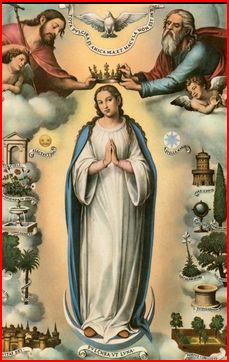
The Egyptian Ankh
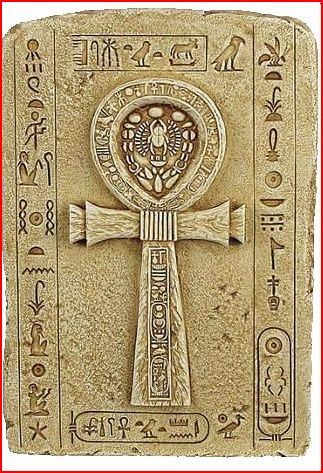
Early Christian Cross
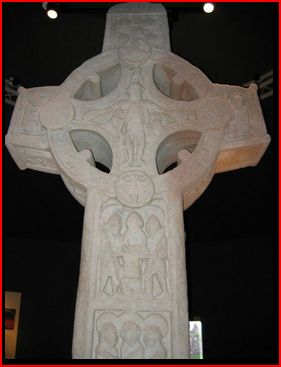
Jesus is represented as the sign of the fish, not because he was a fisherman, but because mythology dictated a leader to come at the beginning of each new age. The progression of the equinox move backwards through the Zodiac. Moses represented the turning of ages from Taurus the Bull to Aries the Ram. That is why the "Golden Calf" was blasphemy and the sacrificial ram/lamb was the new vogue. Jesus' birth heralded the age of Pisces. The Aries ram/lamb was no longer the Zodiac sign during sunrise, Pisces was the birth place of the sun every morning for the next 2000 or so years. We are now in the Age of Aquarius.
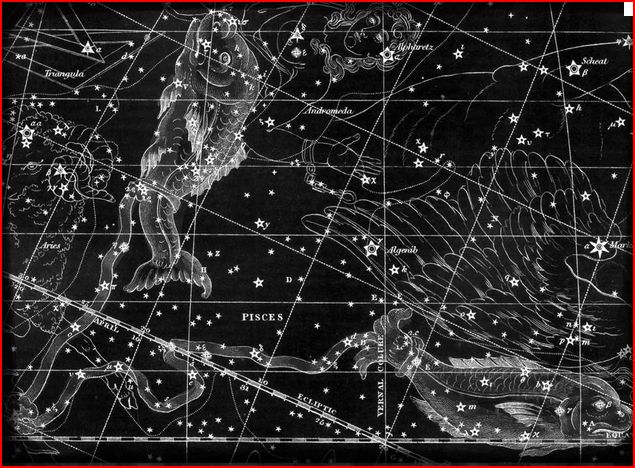
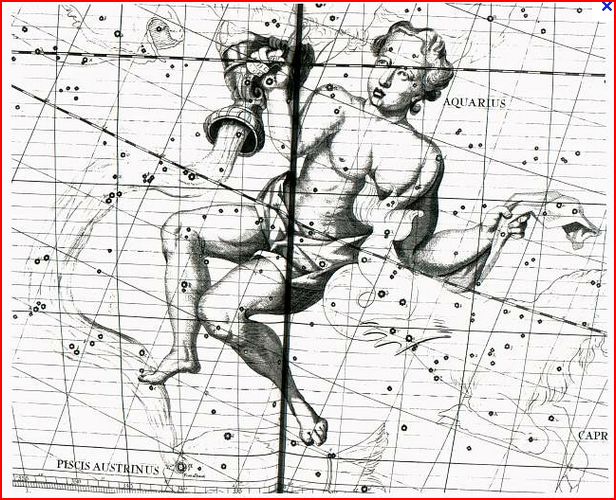

infinite712.hubpages.com...#
The story of Jesus Christ is in fact a modern version of this very same solar myth.
In 312 C.E., Constantine prepared to battle Maxentius for control of the Roman Empire. At broad daylight he claimed to see a cross symbol above the sun. Above the sign was the inscription, In hoc signo vinces “by this sign conquer”. The next morning he had his army carry this “sign” that he had seen early into battle. This sign was made using the Greek letters chi “X” and rho “P” as an abbreviation for Christ.
Constantine then embraced the sun god of the Christians and this new religion was suddenly very popular in Rome. The truth is that Constantine viewed Christ as just another sun god who had provided him with his victory over Maxentius, and that this new Christian god could be used as a political tool, as well as bringing about homogeneity to the culture of ancient Rome during the council of Nicea in 325 C.E.
"The fable of Christ and his twelve apostles, which is a parody on the sun and the twelve signs of the zodiac, copied from the ancient religions of the eastern world, is the least hurtful part. Everything told of Christ has reference to the sun. His reported resurrection is at sunrise, and that on the first day of the week; that is, on the day anciently dedicated to the sun, and from thence called Sunday — in Latin Dies Solis, the day of the sun; as the next day, Monday, is Moon-day. But there is no room in a letter to explain these things."
- Thomas Paine
The Perpetual Virgin Goddess, Isis

The Virgin Mary

The Egyptian Ankh

Early Christian Cross

Jesus is represented as the sign of the fish, not because he was a fisherman, but because mythology dictated a leader to come at the beginning of each new age. The progression of the equinox move backwards through the Zodiac. Moses represented the turning of ages from Taurus the Bull to Aries the Ram. That is why the "Golden Calf" was blasphemy and the sacrificial ram/lamb was the new vogue. Jesus' birth heralded the age of Pisces. The Aries ram/lamb was no longer the Zodiac sign during sunrise, Pisces was the birth place of the sun every morning for the next 2000 or so years. We are now in the Age of Aquarius.

The character of Jesus Christ is a mythological sun god and the early Christians believed in the superstition of Astrology. Early Christian churches used the symbol of the fish to represent the age of Pisces. Modern Christians still use this fish imagery without ever realizing that it’s an astrological symbol. The New Testament itself is full of references to fish symbology, “fishers of men”, “Jesus fed the masses with two fish”(constellation Pisces), etc. The New Testament often talks about the “end of the age”(sometimes mistranslated as “end of the world”). The ending age that they were talking about was the age of Pisces. The next will be the age of Aquarius. Aquarius is symbolized by Luke 22:10: “He replied, “As soon as you enter Jerusalem, a man carrying a pitcher of water will meet you. Follow him. At the house he enters,”. The “house” refers to the house of the zodiac, the man carrying a pitcher of water is Aquarius. infinite712.hubpages.com...

reply to post by windword
Dear windword,
Thank you twice over, once for coming back and twice for your valuable and artistic contribution. They caused me to think and do a little basic searching. I'm very grateful to you.
If I understand properly you talked about Jesus as Sun God and showed the picture of the halo. I'm not sure if you are talking about Sol Invictus as the model for Jesus, or Mithra, or some combination. But if I could spend a second on the halo?
Halos? Buddha has one, so do Hindu and Chinese holy figures (and some emperors). They often show up on Mohammed (back when one was allowed to make pictures of him). Poseidon, Apollo, Alexander the Great, some Roman emperors, angels, normal humans who were considered saints, and Old Testament prophets. Even Judas and Satan have been shown with halos. (But their halos are always in black.)
I think a halo is more a sign of spiritual power or grace than a reference to the sun god.
I asked Wiki (I know, superficial research) about Isis to see what there was to the idea that she was a model for Mary. This is what I found:
The Zodiac discussion was interesting and interesting and new to me, thanks. Here's something I found on this specific subject:
Age of Aquarius
You and WalterRatlos are providing valuable work. I wish every ATSer could come and see what you two are doing, thanks.
With respect,
Charles1952
Dear windword,
Thank you twice over, once for coming back and twice for your valuable and artistic contribution. They caused me to think and do a little basic searching. I'm very grateful to you.
If I understand properly you talked about Jesus as Sun God and showed the picture of the halo. I'm not sure if you are talking about Sol Invictus as the model for Jesus, or Mithra, or some combination. But if I could spend a second on the halo?
Halos? Buddha has one, so do Hindu and Chinese holy figures (and some emperors). They often show up on Mohammed (back when one was allowed to make pictures of him). Poseidon, Apollo, Alexander the Great, some Roman emperors, angels, normal humans who were considered saints, and Old Testament prophets. Even Judas and Satan have been shown with halos. (But their halos are always in black.)
I think a halo is more a sign of spiritual power or grace than a reference to the sun god.
I asked Wiki (I know, superficial research) about Isis to see what there was to the idea that she was a model for Mary. This is what I found:
www.ask.com... Okay, it is an unusual birth, but certainly not virginal. And I really can't see Christians using this as their model for Mary. It's about as different a birth story as I can imagine.
The most extensive account of the Isis-Osiris story known today is Plutarch's Greek description written in the 1st century CE, usually known under its Latin title De Iside et Osiride.
In that version, Set held a banquet for Osiris in which he brought in a beautiful box and said that whoever could fit in the box perfectly would get to keep it. Set had measured Osiris in his sleep and made sure that he was the only one who could fit the box. Several tried to see whether they fit. Once it was Osiris's turn to see if he could fit in the box, Set closed the lid on him so that the box was now a coffin for Osiris. Set flung the box in the Nile so that it would drift far away. Isis went looking for the box so that Osiris could have a proper burial. She found the box in a tree in Byblos, a city along the Phoenician coast, and brought it back to Egypt, hiding it in a swamp. But Set went hunting that night and found the box. Enraged, Set chopped Osiris's body into fourteen pieces and scattered them all over Egypt to ensure that Isis could never find Osiris again for a proper burial.
Isis and her sister Nephthys went looking for these pieces, but could only find thirteen of the fourteen. Fish had swallowed the last piece, his phallus, so Isis made him a new one with magic, putting his body back together after which they conceived Horus. The number of pieces is described on temple walls variously as fourteen and sixteen, and occasionally forty-two, one for each nome or district.
The Zodiac discussion was interesting and interesting and new to me, thanks. Here's something I found on this specific subject:
In the movie "Zeitgeist", Peter Joseph has a section about "ages."
He says that the Exodus took place at the beginning of the age of Aries, the Ram, which he says began in 2150 B.C. The problem is that the Exodus probably took place around 1450 B.C., and the earliest I've ever seen anyone date it is around 1600 B.C. He's off by at least half a millenium.
He goes on to say that a new astrological age (the age of Pisces) began in 1 A.D. when Jesus was born. Actually, when one astrological age ends and where another begins depends on the interpretation, since the borders between constellations are, of course, vague. Some put the dawning of the age of Pisces as early as 100 B.C., others as late as 498 A.D. Given a roughly 600-year period in which the age of Pisces can be said to have begun, the fact that Jesus' birth fell somewhere into this isn't as significant as Joseph would make it sound.
Age of Aquarius
You and WalterRatlos are providing valuable work. I wish every ATSer could come and see what you two are doing, thanks.
With respect,
Charles1952
reply to post by windword
1. Jesus as a sun God: Nope that's just a holy halo around his head; that's how painters used to depict holy man. And Constantine was just a shrewd politician. At the time of this anecdote he was a follower of the Sol Invictus religion, but had also some Christian influence through his mother Helen. And contrary to what your source says, he did not embrace it right away. For years after he became Emperor, he would still use the Sol Invictus symbol on coins and he was baptized on his deathbed. As I said he was a shrewd politician. He was fighting a civil war and he knew it would be easier to fight fellow Roman legionaries, if he changed the symbol from the Eagle of the Republic to that of a cross. Plus, it is assumed that at that time he might have had many Christians serving in his army already.
2. The ankh: what's your point? That the Christian cross is not original? The thing is the cross is a very ancient symbol, but it became a symbol of Christianity, because supposedly Jesus was crucified on a cross not because they adopted it from some other religion.
3. The early Christian fish symbol was not used because he was a fisherman, he was supposedly a carpenter, nor because of the Pisces constellation, but because some of his disciples were fisherman and because Jesus said to them he would make them fishers of man and possibly because of the fish and bread feeding miracle. It had nothing to do with astrology. The fact that the number of the Apostles equals the number of zodiac signs might just be a coincidence.
reply to post by charles1952
Thank you for your kind words!
1. Jesus as a sun God: Nope that's just a holy halo around his head; that's how painters used to depict holy man. And Constantine was just a shrewd politician. At the time of this anecdote he was a follower of the Sol Invictus religion, but had also some Christian influence through his mother Helen. And contrary to what your source says, he did not embrace it right away. For years after he became Emperor, he would still use the Sol Invictus symbol on coins and he was baptized on his deathbed. As I said he was a shrewd politician. He was fighting a civil war and he knew it would be easier to fight fellow Roman legionaries, if he changed the symbol from the Eagle of the Republic to that of a cross. Plus, it is assumed that at that time he might have had many Christians serving in his army already.
2. The ankh: what's your point? That the Christian cross is not original? The thing is the cross is a very ancient symbol, but it became a symbol of Christianity, because supposedly Jesus was crucified on a cross not because they adopted it from some other religion.
3. The early Christian fish symbol was not used because he was a fisherman, he was supposedly a carpenter, nor because of the Pisces constellation, but because some of his disciples were fisherman and because Jesus said to them he would make them fishers of man and possibly because of the fish and bread feeding miracle. It had nothing to do with astrology. The fact that the number of the Apostles equals the number of zodiac signs might just be a coincidence.
edit on 5/6/2012 by WalterRatlos because: spelling, grammar and syntax
reply to post by charles1952
Thank you for your kind words!
edit on 5/6/2012 by WalterRatlos because: spelling, grammar and syntax and to add another reply
reply to post by WalterRatlos


And Pi is just a number and the pyramids are just fancy triangles!
This thread isn't about proving that Jesus is a sun god. It's about proving that Christianity was influenced and molded by pre-existing religions and myths.
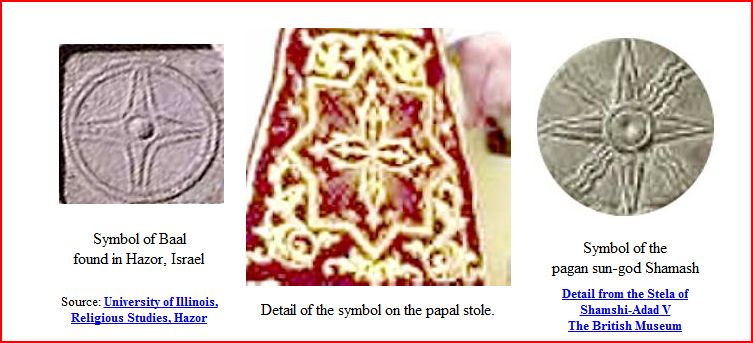
St Peter Square at the Vatican. Clearly a replica of the symbolism of solar deities. At the very least, the Egyptian obelisk at the center of the square makes for a great sundial!
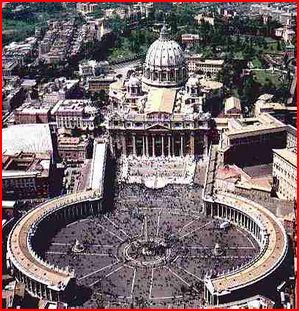
1. Jesus as a sun God: Nope that's just a holy halo around his head; that's how painters used to depict holy man.


And Constantine was just a shrewd politician. At the time of this anecdote he was a follower of the Sol Invictus religion
And Pi is just a number and the pyramids are just fancy triangles!
This thread isn't about proving that Jesus is a sun god. It's about proving that Christianity was influenced and molded by pre-existing religions and myths.

St Peter Square at the Vatican. Clearly a replica of the symbolism of solar deities. At the very least, the Egyptian obelisk at the center of the square makes for a great sundial!

reply to post by charles1952
Engineering an homogenous religion for mass consumption is a tedious process. It is important to weave mostly truth into the lies, and patience and time are certainly important ingredients.
The halo does seem to be unique to Christianity, which makes me wonder if Jesus really did visit India.

reluctant-messenger.com...
I do believe that the Buddhas that are portrayed with halos are of Christian influence. Not all Buddha statues have halos.
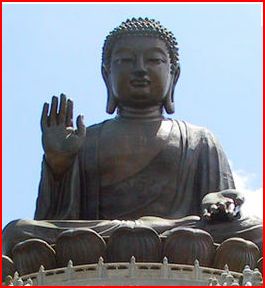
Halos? Buddha has one, so do Hindu and Chinese holy figures (and some emperors). They often show up on Mohammed (back when one was allowed to make pictures of him). Poseidon, Apollo, Alexander the Great, some Roman emperors, angels, normal humans who were considered saints, and Old Testament prophets. Even Judas and Satan have been shown with halos. (But their halos are always in black.)
I think a halo is more a sign of spiritual power or grace than a reference to the sun god.
Engineering an homogenous religion for mass consumption is a tedious process. It is important to weave mostly truth into the lies, and patience and time are certainly important ingredients.
The halo does seem to be unique to Christianity, which makes me wonder if Jesus really did visit India.

reluctant-messenger.com...
Ancient scrolls reveal that Jesus spent seventeen years in India and Tibet
From age thirteen to age twenty-nine, he was both a student and teacher of Buddhist and Hindu holy men
The story of his journey from Jerusalem to Benares was recorded by Brahman historians
Today they still know him and love him as St. Issa. Their 'buddha'
I do believe that the Buddhas that are portrayed with halos are of Christian influence. Not all Buddha statues have halos.

reply to post by windword
Hey girl!
(Is that my son? I swear that could be my boy 2-3 years ago...his hair is cut short now )
Those pics are awesome...just wanted to bump your efforts here. I found an interesting website today that I'm thinking of sparking a thread with.....
how Apologetics is best debunked....
Thanks for the info and input here
Wild
Hey girl!
(Is that my son? I swear that could be my boy 2-3 years ago...his hair is cut short now )
Those pics are awesome...just wanted to bump your efforts here. I found an interesting website today that I'm thinking of sparking a thread with.....
how Apologetics is best debunked....
Thanks for the info and input here
Wild
reply to post by wildtimes
Hey Wild,
Good to see you here! I think that sounds like an compelling thread. PM me when you get it up!
I see you got your "writer status!" Congrats!
Hey Wild,
Good to see you here! I think that sounds like an compelling thread. PM me when you get it up!
I see you got your "writer status!" Congrats!
Originally posted by windword
reply to post by WalterRatlos
And Pi is just a number and the pyramids are just fancy triangles!
And your point is? You known I can play that game too, but it does not contribute much productive and constructive to the discussion at hand.
This thread isn't about proving that Jesus is a sun god. It's about proving that Christianity was influenced and molded by pre-existing religions and myths.
No argument there, but you brought up the Jesus as a sun God claim, not me.
St Peter Square at the Vatican. Clearly a replica of the symbolism of solar deities. At the very least, the Egyptian obelisk at the center of the square makes for a great sundial!
Yeah, it's a great sundial, that is why it is probably there, probably erected at a time when people still measured time with sundials and hourglasses. As for the St Peter Square being a replica of the symbolism of solar deities, sorry, I don't see it, but I'm no expert on symbolism nor on solar deities.
No, St. Peters Square isn't a tribute to Sun Deities. Just like all of the Pine Cones at the Vatican aren't supposed to Symbolize the Pineal Gland.
Just like there is no symbolism behind anything...the people who make these things want to make them as simple as possible so everybody, even special
people, can understand them
Just like how the expression "read between the lines" is impossible because there are no words between the lines.
Seriously, use the only thing that separates you from the animals - your *&&%& brain.
Just like how the expression "read between the lines" is impossible because there are no words between the lines.
Seriously, use the only thing that separates you from the animals - your *&&%& brain.
No, St. Peters Square isn't a tribute to Sun Deities. Just like all of the Pine Cones at the Vatican aren't supposed to Symbolize the Pineal Gland.
Just like there is no symbolism behind anything...the people who make these things want to make them as simple as possible so everybody, even special
people, can understand them
Just like how the expression "read between the lines" is impossible because there are no words between the lines.
Seriously, use the only thing that separates you from the animals - your *&&%& brain.
Just like how the expression "read between the lines" is impossible because there are no words between the lines.
Seriously, use the only thing that separates you from the animals - your *&&%& brain.
Misc. thoughts.
Surely, the symbol doesn't matter, what's important is the meaning the symbol has. Buddhism uses the swastika, does that mean that Buddhism is a part of Nazism?
Jesus studying Buddhism in Tibet? Don't think so, Jesus was long gone.
www.ask.com...
I would expect Christianity to reflect something from every religion, not because it is copying from those religions but because there is some truth that all religions try to describe (with varying degrees of success). Does the religion describe Him as a loving God? If so, that's not because people are copying each other, but because they've all found a truth, He is. Give a class a math problem and many of the answers will be the same. Did they cheat? No, they all worked it out correctly. Some students, and some religions, will get the answer wrong or will work the problem out differently. If Christianity was made up of entirely new beliefs and morals, I would disbelieve it.
The ankh? An Egyptian fertility symbol combining symbols for the male and female. The Cross? A fairly realistic depiction of a place of death and shame. Nearly completely opposite meanings. I suppose if we were coming up with a Christian symbol today it might be the electric chair.
With respect to you all,
Charles1952
P.s. I would like to see that website or thread that does all the debunking, too. My position and WalterRatlos' may be similar. "Poke around every bush and down every hole, find new things and enjoy yourself." So far, for me, that's what's happening here. Thank you.
Surely, the symbol doesn't matter, what's important is the meaning the symbol has. Buddhism uses the swastika, does that mean that Buddhism is a part of Nazism?
Jesus studying Buddhism in Tibet? Don't think so, Jesus was long gone.
In the reign of King Thothori Nyantsen (5th century CE), a basket of Buddhist scriptures arrived in Tibet from India. Written in Sanskrit, they were not translated into Tibetan until the reign of king Songtsän Gampo (618-649). While there is doubt about the level of Songtsän Gampo's interest in Buddhism, it is known that he married a Chinese Tang Dynasty Buddhist princess, Wencheng, who came to Tibet with a statue of Shakyamuni Buddha.
www.ask.com...
I would expect Christianity to reflect something from every religion, not because it is copying from those religions but because there is some truth that all religions try to describe (with varying degrees of success). Does the religion describe Him as a loving God? If so, that's not because people are copying each other, but because they've all found a truth, He is. Give a class a math problem and many of the answers will be the same. Did they cheat? No, they all worked it out correctly. Some students, and some religions, will get the answer wrong or will work the problem out differently. If Christianity was made up of entirely new beliefs and morals, I would disbelieve it.
The ankh? An Egyptian fertility symbol combining symbols for the male and female. The Cross? A fairly realistic depiction of a place of death and shame. Nearly completely opposite meanings. I suppose if we were coming up with a Christian symbol today it might be the electric chair.
With respect to you all,
Charles1952
P.s. I would like to see that website or thread that does all the debunking, too. My position and WalterRatlos' may be similar. "Poke around every bush and down every hole, find new things and enjoy yourself." So far, for me, that's what's happening here. Thank you.
Originally posted by charles1952
Misc. thoughts.
Surely, the symbol doesn't matter, what's important is the meaning the symbol has. Buddhism uses the swastika, does that mean that Buddhism is a part of Nazism?
Buddhism and the Swastika predate the Nazis by 1000's of years, so, your point is moot.
However, the Swasika is an interesting study.
www.foreigners-in-china.com...
Generally, people regard that swastika symbols mean "good fortune", but most people have forgotten the very original meaning of the symbols. The very origin of swastika symbols is not from human world but from Buddha's paradise. It is a mark on Buddha's body that represents the Buddha's level and status in heaven.
The Buddhist Religious symbols – Swastika can be also found in the Ancient Greek cultural relics found in Europe.
During the Big Flood, some ancient Greek people who lived to the south-west of Himalayas Mountain survived. They are the current white-skin Indians and were called Brahmans at that time. Originally in Brahmanism, people believed in Buddha, which was the inheritance of the Buddha belief of ancient Greek people.
They also inherited the sculpturing methods from Ancient Greece. So the ancient Indian Buddha statues were in Ancient Greek style. This sculpture art also spread from India into China together with Buddhism. So you will find some Asian Buddha statues having deep eyes and straight nose. The eyebrow outline and facial outline of the statues are just like western people's outline.
Clearly their was communication going on between the ancient Greeks and the eastern world. Buddhism was being practiced in ancient Greece. Probably introduced because of Alexander the Great.
Buddha found patronage in the ruler of Magadha, emperor Bimbisāra. The emperor accepted Buddhism as his personal faith and allowed the establishment of many Buddhist vihāras. This eventually led to the renaming of the entire region as Bihār.
Buddha was well financed, which allowed for his message to spread more easily than if he had been a poor monk wandering about.
en.wikipedia.org...
At the Deer Park near Vārāṇasī in northern India, Buddha set in motion Wheel of Dharma by delivering his first sermon to a group of five companions with whom he had previously sought enlightenment. Together with the Buddha they formed the first Saṅgha, the company of Buddhist monks, and hence, the first formation of the Triple Gem (Buddha, Dharma and Saṅgha) was completed.
The Holy Trinity's origin?
Just before Buddha died, he reportedly told his followers that thereafter the Dharma (doctrine, teaching) would be their leader. The early arhants considered Gautama's words the primary source of Dharma and Vinaya (rules of discipline and community living), and took great pains to formulate and transmit his teachings accurately. Nonetheless, no ungarnished collection of his sayings has survived. The versions of the canon (accepted scripture) preserved in Pāli, Sanskrit, Chinese, and Tibetan are sectarian variants of a corpus that grew and crystallized during three centuries of oral transmission.[7]
By the time of Buddha's death, his religion was well established.
Jesus studying Buddhism in Tibet? Don't think so, Jesus was long gone.
In the reign of King Thothori Nyantsen (5th century CE), a basket of Buddhist scriptures arrived in Tibet from India. Written in Sanskrit, they were not translated into Tibetan until the reign of king Songtsän Gampo (618-649). While there is doubt about the level of Songtsän Gampo's interest in Buddhism, it is known that he married a Chinese Tang Dynasty Buddhist princess, Wencheng, who came to Tibet with a statue of Shakyamuni Buddha.
Wait, you do know that Buddha predates Jesus by almost 500 years? If Buddha's message was written in Sanskrit, that means the religion was being practiced in the area of Iran in ancient times. It is easy to see that Jesus could very well have studied Buddhism during his lifetime, even if he never went to Tibet.
Maybe those 3 wise men from the east, that reportedly visit Jesus at birth, were Buddhist monks....
I would expect Christianity to reflect something from every religion, not because it is copying from those religions but because there is some truth that all religions try to describe (with varying degrees of success). Does the religion describe Him as a loving God?
You will be hard pressed to find evidence of a loving god in the OT. Jesus introduced the concept of a loving god to the followers of Jehovah.
Christianity isn't a carbon copy of one religion or of parts of some religions. It is layered with symbolism of religious concepts gleamed from all over the world. It is an elaborately engineered system with over 30,000 sects.
new topics
-
School shooting in Madison Wi.
Social Issues and Civil Unrest: 2 hours ago -
Prisoner CNN helped free from Syrian prison was actually notorious Assad regime torturer: report
Mainstream News: 4 hours ago -
Labour Plotting to Postpone May's Council Elections ?
Regional Politics: 5 hours ago -
Is this really what is going on?
General Conspiracies: 6 hours ago -
Russias War Against Religion in Ukraine
World War Three: 7 hours ago -
iPhone Microphone Being Accessed by Unknown App
The Gray Area: 9 hours ago
top topics
-
iPhone Microphone Being Accessed by Unknown App
The Gray Area: 9 hours ago, 10 flags -
Is this really what is going on?
General Conspiracies: 6 hours ago, 10 flags -
Prisoner CNN helped free from Syrian prison was actually notorious Assad regime torturer: report
Mainstream News: 4 hours ago, 8 flags -
School shooting in Madison Wi.
Social Issues and Civil Unrest: 2 hours ago, 7 flags -
Democrats send letter to Biden urging him to ratify Equal Rights Amendment
US Political Madness: 15 hours ago, 4 flags -
Russias War Against Religion in Ukraine
World War Three: 7 hours ago, 4 flags -
Labour Plotting to Postpone May's Council Elections ?
Regional Politics: 5 hours ago, 2 flags
active topics
-
Is this really what is going on?
General Conspiracies • 39 • : matafuchs -
School shooting in Madison Wi.
Social Issues and Civil Unrest • 10 • : grey580 -
Defending the need for adherence to Old Testament commandments under the new covenant of Christ
Conspiracies in Religions • 31 • : Lazy88 -
-@TH3WH17ERABB17- -Q- ---TIME TO SHOW THE WORLD--- -Part- --44--
Dissecting Disinformation • 3719 • : Thoughtful3 -
iPhone Microphone Being Accessed by Unknown App
The Gray Area • 2 • : VictorVonDoom -
Post A Funny (T&C Friendly) Pic Part IV: The LOL awakens!
General Chit Chat • 7917 • : KrustyKrab -
Labour Plotting to Postpone May's Council Elections ?
Regional Politics • 2 • : gortex -
Prisoner CNN helped free from Syrian prison was actually notorious Assad regime torturer: report
Mainstream News • 1 • : AgarthaSeed -
Something better
Dissecting Disinformation • 32 • : fringeofthefringe -
Drones everywhere in New Jersey ---and Elsewhere Master Thread
Aliens and UFOs • 190 • : underpass61
